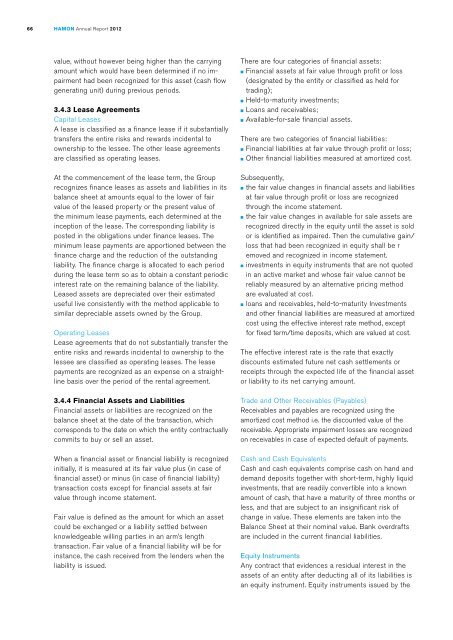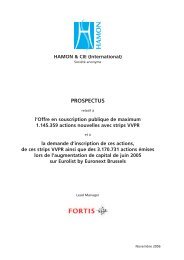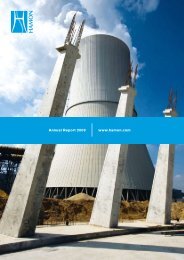Download PDF version English (3237KB) - Hamon
Download PDF version English (3237KB) - Hamon
Download PDF version English (3237KB) - Hamon
You also want an ePaper? Increase the reach of your titles
YUMPU automatically turns print PDFs into web optimized ePapers that Google loves.
66<br />
<strong>Hamon</strong> Annual Report 2012<br />
value, without however being higher than the carrying<br />
amount which would have been determined if no impairment<br />
had been recognized for this asset (cash flow<br />
generating unit) during previous periods.<br />
3.4.3 Lease Agreements<br />
Capital Leases<br />
A lease is classified as a finance lease if it substantially<br />
transfers the entire risks and rewards incidental to<br />
ownership to the lessee. The other lease agreements<br />
are classified as operating leases.<br />
At the commencement of the lease term, the Group<br />
recognizes finance leases as assets and liabilities in its<br />
balance sheet at amounts equal to the lower of fair<br />
value of the leased property or the present value of<br />
the minimum lease payments, each determined at the<br />
inception of the lease. The corresponding liability is<br />
posted in the obligations under finance leases. The<br />
minimum lease payments are apportioned between the<br />
finance charge and the reduction of the outstanding<br />
liability. The finance charge is allocated to each period<br />
during the lease term so as to obtain a constant periodic<br />
interest rate on the remaining balance of the liability.<br />
Leased assets are depreciated over their estimated<br />
useful live consistently with the method applicable to<br />
similar depreciable assets owned by the Group.<br />
Operating Leases<br />
Lease agreements that do not substantially transfer the<br />
entire risks and rewards incidental to ownership to the<br />
lessee are classified as operating leases. The lease<br />
payments are recognized as an expense on a straightline<br />
basis over the period of the rental agreement.<br />
3.4.4 Financial Assets and Liabilities<br />
Financial assets or liabilities are recognized on the<br />
balance sheet at the date of the transaction, which<br />
corresponds to the date on which the entity contractually<br />
commits to buy or sell an asset.<br />
When a financial asset or financial liability is recognized<br />
initially, it is measured at its fair value plus (in case of<br />
financial asset) or minus (in case of financial liability)<br />
transaction costs except for financial assets at fair<br />
value through income statement.<br />
Fair value is defined as the amount for which an asset<br />
could be exchanged or a liability settled between<br />
knowledgeable willing parties in an arm’s length<br />
transaction. Fair value of a financial liability will be for<br />
instance, the cash received from the lenders when the<br />
liability is issued.<br />
There are four categories of financial assets:<br />
■ Financial assets at fair value through profit or loss<br />
(designated by the entity or classified as held for<br />
trading);<br />
■ Held-to-maturity investments;<br />
■ Loans and receivables;<br />
■ Available-for-sale financial assets.<br />
There are two categories of financial liabilities:<br />
■ Financial liabilities at fair value through profit or loss;<br />
■ Other financial liabilities measured at amortized cost.<br />
Subsequently,<br />
■ the fair value changes in financial assets and liabilities<br />
at fair value through profit or loss are recognized<br />
through the income statement.<br />
■ the fair value changes in available for sale assets are<br />
recognized directly in the equity until the asset is sold<br />
or is identified as impaired. Then the cumulative gain/<br />
loss that had been recognized in equity shall be r<br />
emoved and recognized in income statement.<br />
■ investments in equity instruments that are not quoted<br />
in an active market and whose fair value cannot be<br />
reliably measured by an alternative pricing method<br />
are evaluated at cost.<br />
■ loans and receivables, held-to-maturity Investments<br />
and other financial liabilities are measured at amortized<br />
cost using the effective interest rate method, except<br />
for fixed term/time deposits, which are valued at cost.<br />
The effective interest rate is the rate that exactly<br />
discounts estimated future net cash settlements or<br />
receipts through the expected life of the financial asset<br />
or liability to its net carrying amount.<br />
Trade and Other Receivables (Payables)<br />
Receivables and payables are recognized using the<br />
amortized cost method i.e. the discounted value of the<br />
receivable. Appropriate impairment losses are recognized<br />
on receivables in case of expected default of payments.<br />
Cash and Cash Equivalents<br />
Cash and cash equivalents comprise cash on hand and<br />
demand deposits together with short-term, highly liquid<br />
investments, that are readily convertible into a known<br />
amount of cash, that have a maturity of three months or<br />
less, and that are subject to an insignificant risk of<br />
change in value. These elements are taken into the<br />
Balance Sheet at their nominal value. Bank overdrafts<br />
are included in the current financial liabilities.<br />
Equity Instruments<br />
Any contract that evidences a residual interest in the<br />
assets of an entity after deducting all of its liabilities is<br />
an equity instrument. Equity instruments issued by the














